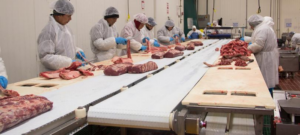How Tubular Heating Elements Maximize Heat Transfer in Food Processing
Last updated on May 17th, 2025 at 07:03 am
From the dawn of human civilization to our modern era, heat has played a vital role in making food safe and savory. Effective heating has always been essential, whether using fire to cook raw game or industrial ovens to process and package food.
Efficient heat transfer ensures that our food is subjected to precise temperatures consistently to ensure they’re edible. Of course, improper conditions undermine food safety. Tubular heating elements, however, can maximize heat transfer for food processing applications and prevent inefficiencies. 
Role of heat transfer in food processing
Almost all food processing applications need some form of heat transfer. Many keep our favorite entrees pathogen-free to prevent foodborne illness. Of course, other applications rely on heat transfer to ensure certain foods come in a shape or form that customers expect, while others make certain foods easier to store.
Food processes reliant on effective heat transfer
- Sterilization and pasteurization: These processes use heat to kill disease-causing microorganisms in food using dry heat, moist heat, or irradiation. These processes also allow food manufacturers to extend the shelf life of their products.
- Drying and dehydration: Heat transfer is essential to remove moisture from certain foods. The heat evaporates water in an item, shifting its molecular structure and mass, so it becomes a dry, non-perishable item (i.e., dried fruit, nuts).
- Cooking: Whether it’s cooking, baking, or frying, heat transfer must remain steady for foods to reach an intended texture and state. This also is true for many beverages.
Many more processes rely on effective heat transfer, its three main methods being convection, conduction, and irradiation. Certain problems can reduce the efficiency of heat transfer.
Fouling effects on heat transfer
Numerous factors can affect heat transfer, including poor insulation or watt density problems. But few issues are as notorious as fouling. Essentially, fouling refers to undesirable deposits that collect on heat transfer surfaces. These deposits can be organic or inorganic. Regardless of their form, they increase heat transfer resistance, which reduces the heater element’s performance.
Examples of heater element fouling
- Biological fouling: Settling of microbes that produce biofilm or sludge on heating equipment.
- Corrosion fouling: Weakening of heater element metals due to chemical reactions that turn them into oxides and sulfides, which make them less able to transfer heat.
- Particulate fouling: Collection of fine particles on heater element surfaces that reduce their ability to transfer heat.
- Scale fouling: Precipitation of minerals in water that builds up on heater elements, forming crystals that reduce heat transfer within the element.
In the food industry, fouling is a problem because it contributes to heat loss. A loss of heat means reduced efficiency because plant staff will need to increase their heater’s output, raising their heating costs. This increased usage also means more wear and tear on the heater element, which means more repairs or replacements. Ultimately, that means increased maintenance costs.
In the case of biological fouling, there is a risk that surviving microbes may contaminate food products. Above all, poor heat transfer makes it difficult to heat food products appropriately, and they may fail to meet consumer requirements.
Tubular heating elements for food processing (advantages)
Choosing the right materials is one of the most crucial ways to prevent fouling. Stronger metals maintain their structural integrity and don’t weaken as a result. The opposite is true for weaker metals; they degrade structurally and can’t transfer heat as efficiently. Another way to prevent fouling is to wrap heater elements in a protective sheath, so particles don’t collect on them.
Wattco tubular heater elements come in various metals ranging from steel and stainless steel to Incoloy and titanium. These metals are highly resistant to degradation, and when combined with a protective sheath, there is even greater protection against structural weakening.
There are other functional ways to reduce fouling. For example, you can add compounds to increase heat transfer efficiency. Here at Wattco, we add high-grade magnesium oxide in our tubular heaters to increase heat transfer efficiency, which reduces the need to manually increase power output.
In the food-processing industry, tubular heating elements work well because they can heat liquids, gasses, and solids in process temperatures of up to 750°C (1,382°F). That covers a wide range of food processes, whether for general cooking or sterilization efforts. Also, the versatility of these heaters allows for various shapes and diameters, which we will customize for your food application.
Additional benefits of tubular heating elements in food
- Temperature control accuracy: Operators can maintain desired temperatures with temperature control panels and thermocouples. This helps improve the overall quality of a food processing application since there is no temperature fluctuation.
- Thermal response speed: The combination of materials and heat transfer metals allows for faster heat transfer and optimal heating in less time. This helps reduce operating costs.
Also read: Heat Transfer in the Food Processing Industry
Going tubular for food heating
Fouling is a complex issue in heat transfer applications, and operators often need a multifaceted approach to stop it. That may include setting up a treatment system or performing regular cleanings to remove contaminants.
However, tubular heating elements can counteract fouling due to their materials, protective sheaths, and added coatings (that maximize heat transfer). They can facilitate virtually all food processes to ensure products are safe to consume, edible, and savory.
Here at Wattco, we offer a selection of tubular heating element options to help you efficiently apply heat to your food applications. We also build custom solutions to meet the demands of your industry, especially if pre-built models don’t suffice.
Get a quote for your tubular heating elements today. Our representatives will help you find the exact setup needed for your industrial needs.
